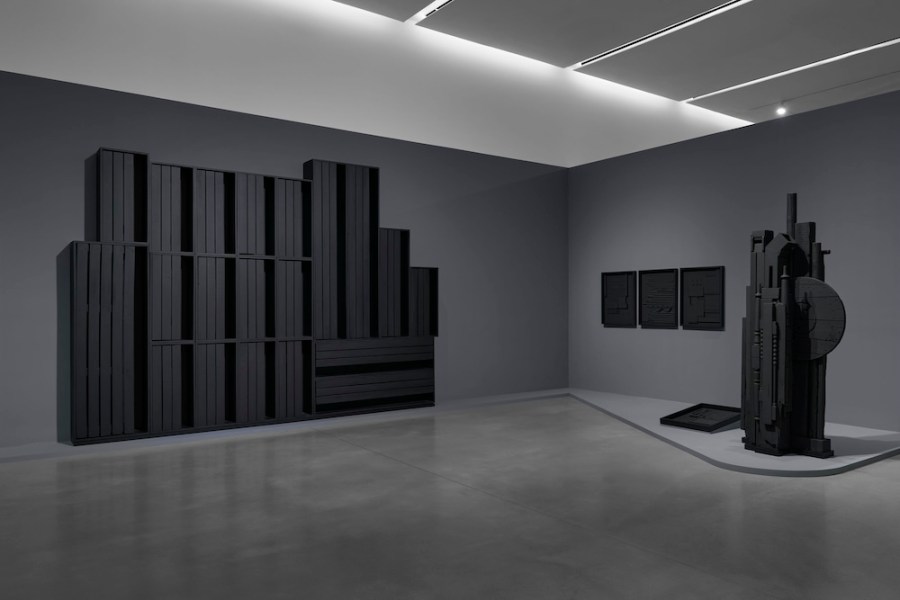Looking at Louise Nevelson’s sculptures feels like standing in front of a high school bully. Hacked-up pieces of furniture are bolted together and painted matte black, or, less often, white. Those that are freestanding tower over me. Those mounted on the wall dominate my field of vision. I’m not sure whether to kowtow or run away.
Despite being acclaimed in her lifetime and well-respected after her death, Nevelson is not as well known outside the art world as she should be. This year however, a grand reappraisal of her work seems to be underway, with upcoming exhibitions at the Pompidou Metz, the Columbus Museum of Art in Ohio and here, in New York, at Pace Gallery.
The Pace show presents work Nevelson made towards the end of her career. She created most of these pieces in her 70s and 80s when, after having spent many decades experimenting with different methods, the mature Nevelson was able to call upon variously perfected techniques at will. There is an understandable urge to view her art through a formalist lens. Her sculptures and lesser-known collages play around with depth and form in a similar fashion to analytic cubism. But focusing too much on the material qualities of her work risks missing its essence. When a college newspaper reporter once attempted to distil it into simple facts – ‘Your work is black and it is wood and it is sculpture’ – Nevelson replied, ‘If that’s what it appears like to you, then you’ve missed the whole thing.’
Artillery Landscape (c. 1985), Louise Nevelson. Courtesy Pace Gallery; © Louise Nevelson/Artists Rights Society (ARS), New York
Her work was as much a response to the despair brought on by two world wars as it was a rebellion against the dominance of Abstract Expressionism. Tired of gunslinging gesture-painters, Nevelson made sculptures out of prefabricated objects and painted them the same colour, erasing any mark of her own, as well as any distinctions between the pieces of these puzzles. From afar, these junk-yard piles merge into singular masses, but when you look more closely to identify the different parts, there is a clear, if shrouded, resemblance to tools of violence. Wooden poles look like missiles. Doorknobs look like grenades. Rectangular crates seem like just the right size to hold sniper rifles. The longer you stare, the more weapons emerge.
There’s an unusual nonchalance about risk and harm in Nevelson’s art. One untitled wall sculpture from 1976–78 contains pieces of wood shaped like blades stacked against each other, which make me think of rummaging through a knife drawer in the dark. The sculptures are not exactly nihilistic. The fact that they inspire a sense of fear suggests that there is still something to lose. But Nevelson – a fiercely independent person, who often chose to live in poverty rather than obey constraints imposed by her husband or gallery – seems to have been willing to put up with the perils of life. She developed a courage – or maybe numbness – that would let her stand with her nose right up against the abyss without flinching. Like a mischievous older sibling trying to get you to look at something scary, she grabs you by the hand and pulls you up to get a closer look.
Installation view of ‘Louise Nevelson: Shadow Dance’ at Pace Gallery, New York (540 West 25th Street). Courtesy Pace Gallery
Like many artists, Nevelson was less present in other areas of her life. She had a troubled relationship with her son, Mike, who later became a sculptor himself – something they might have bonded over, but didn’t. In what may be an homage to the act of sculpting, Moonlight Series IV (1986) looks like a tool drawer tilted on its side and mounted on the wall. Blocks of wood resembling measuring sticks and other instruments stick out of separate compartments as if they might jump out at you. Do tools come to life at night when you turn off the lights and leave the studio? They did for Mike. When he left for the day, she would sometimes go in afterwards and make unsolicited adjustments to his work.
Her white sculptures suggest an uneasy reconciliation between the dramatic weight of her artistic aspirations and the personal difficulties that resulted. Dawn’s Light (1975) is a good example of this: a collection of white wooden slabs combined into shapes resembling buildings. They’re decorated with elegant wavy lines that gesture towards innocence and beauty. One of the boxes, however, has multiple wooden rods sticking out of the top – evoking monsters like the hydra or Cerberus (it’s never good to have too many heads) or, more benignly, a bouquet of flowers.
While a viewer can usually separate themselves from the worlds of even the most frightening paintings – like watching a gorilla behind glass – that is not as easy to do with Nevelson’s work. Looking at her sculptures feels threatening – more like peering down a shady alleyway. But if you feel uneasy in their presence, you can’t blame Nevelson. The objects in her sculptures were already out there: we tossed them to the curb and she brought them back to life.
Portrait of Louise Nevelson © The Estate of Pedro E. Guerrero
‘Louise Nevelson: Shadow Dance’ is at Pace Gallery, New York, until 1 March.
